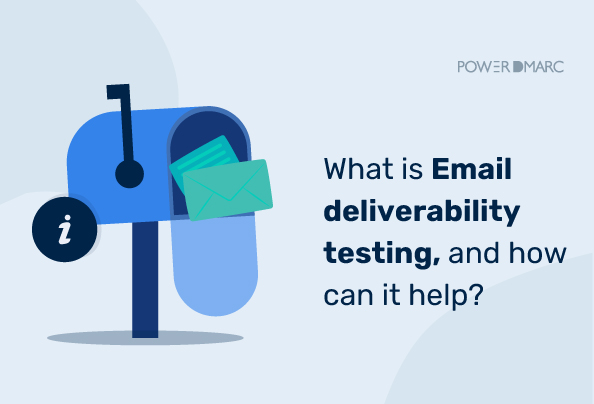Key Takeaways
- Email deliverability ensures emails land in the inbox (aiming for 85-95%), not just the server, impacting campaign success and sender reputation.
- Key factors affecting deliverability include sender reputation, authentication (SPF, DKIM, DMARC), content quality, and list hygiene.
- Regular testing and monitoring of metrics like open, click, and bounce rates help identify issues such as spam filtering, blocklisting, or bounces.
- Best practices include list segmentation, pruning inactive subscribers, personalization, responsive design, and optimizing sending frequency.
- Using deliverability tools and checking authentication, reputation, and blocklist status are essential steps to improve inbox placement.
Imagine sending an email campaign, hitting “Send,” and then sitting back to wait for the opens, clicks, and conversions. But what if most of your messages never actually reach the inbox? That’s where the real issue hides.
In email marketing, there’s a big difference between “sending” and landing in the inbox. Sending is simply your email being accepted by the recipient’s mail server. But landing in the inbox means your message has passed all the filters, avoided the spam folder, and has a real chance of being seen, read, and acted upon. Without that, even the most creative email falls flat.
That’s why email deliverability testing is a critical process. To truly drive results, you need to measure how many of those messages actually reach the inbox, and then craft your campaigns around that reality.
In this article, we’ll explore why deliverability matters, how to test it effectively, and what you can do to improve it. If you’re serious about making your email campaigns work, read on, and let’s dive in.
What is Email Deliverability Testing?

Email deliverability testing measures how effectively your emails reach your audience’s inbox. It focuses on more than just whether an email was sent successfully. The goal is to see where the email ends up once it arrives at the recipient’s mail server.
In simple terms, deliverability testing determines whether your email is delivered to the main inbox, the promotions tab, or the spam folder. It helps you understand inbox placement and identify if your messages are being filtered, flagged, or blocked before they are seen.
This type of testing differs from examining open or bounce rates. Open rates only show how many people opened your email. Bounce rates only show how many emails failed to deliver. Deliverability testing provides a deeper insight by showing how mailbox providers handle your messages and whether your audience can actually see them.
Simplify Security with PowerDMARC!
How to Test Email Deliverability?
Here’s how you can do it:
1. Use deliverability testing tools
These email deliverability tools allow you to send a test email to multiple accounts across different email providers. They check for spam scores, authentication, and inbox placement.
2. Check authentication records
Using tools like PowerDMARC SPF, DKIM, and DMARC checker allows you to verify that your SPF, DKIM, and DMARC records are set up correctly. These are essential for authenticating your emails and improving deliverability. If you use a third-party service that sends emails on your behalf, ensure they are properly authorized in your SPF record to avoid authentication issues.
3. Monitor IP and domain reputation
IP reputation monitoring tools help you monitor the reputation of your sending IPs and domains. A poor reputation can lead to emails being blocked or marked as spam. Sender reputation refers to how well-known you are as an email sender among all major ISPs. In some cases, maintaining strong domain authority through ethical link building practices can also support your domain’s overall trustworthiness.
4. Check for blacklisting
Tools like PowerDMARC’s blacklist monitoring tool can help you determine if your domain or IP is on any major IP or DNS blacklists (also known as blocklists), which can severely affect deliverability.
5. Engagement metrics
Review metrics like open rates, click-through rates (CTR), delivery rate (the number of messages delivered out of all those sent), bounce rates, and unsubscribe rates. Low engagement can be an indicator of deliverability issues. Businesses in niche industries, such as automotive, can benefit from using automotive customer feedback tools to gauge how recipients interact with their messages and tailor future communications accordingly.
6. Review email headers
Use an email header analyzer tool to examine the headers of your sent emails to see how they were processed by different ISPs. This can provide clues about deliverability issues.
The Benefits of Testing Email Deliverability
Email deliverability testing must be done to enhance the efficiency of emails. It provides various benefits, including:

1. Enhancing email engagement levels
With regular deliverability testing, you can optimize various factors influencing email engagement. It allows testing the email subjects, the email content (including images and videos), and other details about that email. Tools like an AI email generator can help streamline the process.
The company can create more personalized and dynamic emails by knowing and controlling the factors that make the email fall into the receiver’s inboxes. This regular testing can prove to help improve email engagement metrics like open and click-through rates. This becomes even more critical during peak promotional periods like Black Friday email campaigns, when inboxes are flooded with offers and messages and here proactive testing ensures messages reach inboxes and drive higher engagement.
2. Improving sender reputation
Email deliverability testing plays a vital role in maintaining the sender’s reputation. The regular testing of email deliverability helps Internet Service Providers (ISPs) monitor the sender’s reputation. It lets them identify scammers.
Regular email deliverability testing helps you identify all those factors that could influence the sender’s reputation. The possible issues include spam complaints, blacklisting, or increased bounce rates. These issues need to be properly addressed to improve your sender’s reputation.
3. Boosting return on investment (ROI)
Effective email deliverability testing also effectively increases your email marketing ROI. It confirms the delivery of the email to the customer’s inboxes. It also lets you increase the revenue generation and likelihood of the conversations.
Regular email deliverability testing reduces the chance of your emails going into the spam folder. Other than this, it also lets you save the budget used on the different email marketing campaigns.
4. Build trust and credibility
If your emails end up in the recipient’s inboxes, your brand’s image increases. The customers know that the emails come from an authentic brand. It increases their trust as well as enhances the brand’s credibility.
Additionally, the increased reputation also increases the likelihood of our email getting opened and read. Therefore, email deliverability testing helps in increasing email engagement.
Common Issues in Email Deliverability
Email deliverability testing is not always right on point. If you are facing difficulties in carrying out the testing, here are some common issues in deliverability testing.
- Spam filters and blacklisting: The spam filters are installed to prevent users from phishing emails. But they sometimes flag the authentic email mistakenly. Other than this, the blacklisted IP addresses also face the deliverability issue. Hence proper monitoring of the popular blacklists is essential to identify this issue.
- Bounces: Bounces occur when an email server receives an invalid address from a recipient’s ISP (Internet service provider). High bounce rates negatively impact your sender reputation and deliverability. It’s crucial to remove bounced addresses from your lists promptly.
- Content triggers: Certain words, phrases, or formatting (like excessive capitalization or spammy links), even within standard email templates, can trigger spam filters. Test your content to ensure it doesn’t raise flags.
- Inconsistent testing conditions: Sometimes, the testing conditions need to be more consistent. All the factors that affect the deliverability of the email are different for different email clients. Hence, one must adequately configure the testing conditions before carrying out the deliverability testing.
- Lack of tracking and analytics: Properly tracking and analyzing the email aspects are essential for email deliverability testing. The deliverability tools provide a detailed metrics analysis to optimize the testing procedures.
- Image blocking: The default features can also affect the email deliverability testing. Many email clients have blocked the image by default. This reduces the visual display of your email. Therefore, it is essential to test the appearance of your email with these blocked images.
Best Practices for Email Deliverability Testing
Deliverability testing is essential to maintain the fluidity of your email communications. There are various essential steps to conduct email deliverability testing, some of which are mentioned below.
Email list cleanup and segmentation
You need to segment and clean up your email lists periodically to maintain good deliverability. Segment the list based on factors like demographic history, engagement level, and purchase history. Targeting specific audiences with personalized content can build trust and increase conversions. Pruning inactive subscribers (those who haven’t opened or clicked in over six months) saves money and improves overall list and email health.
Authenticating the sender
Email deliverability can also be improved by the implementation of email authentication protocols including SPF, DKIM, and DMARC. This helps protect your brand from phishing and ensures ISPs recognize your emails as legitimate.
Monitoring key deliverability metrics
You must also keep a record of key metrics in deliverability. These include the open, bounce, click-through rates (CTR), delivery rates, and spam complaints. The key metrics are essential to consider while improving your email communications.
Implementing A/B testing
It is a tuning test in email marketing that involves the comparison of the two different versions of an email. Both versions are slightly different and are sent to different recipients.
This part of the testing includes the comparison of sender names, the email content, and the subject heading. It makes the senders understand which email has been better crafted and can engage the users. You can also test personalization elements, like adding the recipient’s name to the subject line (e.g., “Top 10 Tips for Jim Smith from ABC Company”).
Checking for blocklist status
You need to check popular IP and domain blocklists regularly, either manually or using a blocklist monitoring online tool. It gives you a heads-up of your blocklisted IPs. If your IP address has been added to a blocklist, it can severely affect your email deliverability.
Optimize sending frequency
Sending too many emails too often can lead to recipient fatigue and increase the likelihood of your messages being filtered as spam. Test different sending frequencies to find the optimal balance for your audience. Consider sending major newsletters perhaps weekly, and other messages less frequently.
Ensure responsive design
Given that more than half of all emails are opened on mobile devices, it’s crucial to use responsive HTML email designs. This ensures your emails adapt to different screen sizes and look great on any device, improving the user experience and engagement.
Top 5 Email Deliverability Testing Tools
Various online tools provide email deliverability testing to analyze the different aspects of your email. Some popular email deliverability testing tools include:
- DMARC reporting tool: This tool provides email sending source analysis, aggregate and forensic report inspection, email header analysis, comprehensive PDF reports on deliverability metrics, as well as predictive threat intelligence analysis.
- Snov.io: This tool provides a Deliverability Checker, Domain Health Checker, Email Placement Test, Spam Checker, and Deliverability Insights among other features.
- Constant Contact: This tool provides Real-Time Account Reputation Monitor, Bounce Management, Spam Checking, and Feedback Analysis.
- Brevo: Offer email deliverability management, and email deliverability monitoring with API integration.
- Omnisend: Offers email list cleaning, and supports implementation of SPF and DKIM authentication protocols.
Conclusion
Email deliverability testing is an important step in ensuring the success of your email marketing campaigns. It helps monitor the issues in the deliverability metrics and address them effectively. You must also incorporate best practices like maintaining list hygiene, authenticating your domain, optimizing content and frequency, and ensuring responsive design to enhance the performance of your emails to ensure you are not falling behind!
To see how your domain performs and uncover what might be holding your emails back, start a free deliverability test with PowerDMARC today. You’ll get clear insights and practical fixes to help your messages reach more inboxes, not spam folders.
For businesses looking to improve their deliverability with email authentication, let us help you! Start a 15-day free trial and book a demo with our deliverability expert to get started.
Frequently Asked Questions
What is a good email deliverability rate for marketing campaigns?
A strong email deliverability rate typically ranges from 95% to 100%. This means that the majority of your emails are successfully reaching recipients’ inboxes instead of being filtered or bounced. If your rate drops below 90%, it’s a sign that you may have issues with sender reputation, authentication, or list quality that need attention.
How often should you perform email deliverability tests?
It’s best to test your email deliverability regularly, especially if you send campaigns often. Running a test once a month is a good starting point, but it’s also essential to test whenever you make major changes to your email templates, sending domains, or marketing platforms. Frequent testing helps you spot issues early and maintain consistent inbox placement over time.

“`
- DMARC MSP Case Study: How PowerDMARC Secures Amalfi Technology Consulting Client Domains from Spoofing - November 17, 2025
- Email Deliverability Testing: What It Is and How to Use It - November 17, 2025
- What Is Fileless Malware? How It Works and How to Stop It - November 14, 2025



